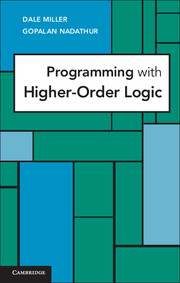Book contents
- Frontmatter
- Contents
- Preface
- Introduction
- 1 First-Order Terms and Representations of Data
- 2 First-Order Horn Clauses
- 3 First-Order Hereditary Harrop Formulas
- 4 Typed λ-Terms and Formulas
- 5 Using Quantification at Higher-Order Types
- 6 Mechanisms for Structuring Large Programs
- 7 Computations over λ-Terms
- 8 Unification of λ-Terms
- 9 Implementing Proof Systems
- 10 Computations over Functional Programs
- 11 Encoding a Process Calculus Language
- Appendix The Teyjus System
- Bibliography
- Index
11 - Encoding a Process Calculus Language
Published online by Cambridge University Press: 05 August 2012
- Frontmatter
- Contents
- Preface
- Introduction
- 1 First-Order Terms and Representations of Data
- 2 First-Order Horn Clauses
- 3 First-Order Hereditary Harrop Formulas
- 4 Typed λ-Terms and Formulas
- 5 Using Quantification at Higher-Order Types
- 6 Mechanisms for Structuring Large Programs
- 7 Computations over λ-Terms
- 8 Unification of λ-Terms
- 9 Implementing Proof Systems
- 10 Computations over Functional Programs
- 11 Encoding a Process Calculus Language
- Appendix The Teyjus System
- Bibliography
- Index
Summary
This chapter considers the encoding of a process calculus within a higher-order logic programming language. Process calculi have been proposed in the literature as a means for modeling concurrent systems. The π-calculus in particular makes use of a sophisticated binding mechanism to encode communication between processes. Our goal here is to show that such binding mechanisms can be treated naturally using λ-tree syntax in λProlog. Since we do not discuss the π-calculus itself in any detail, a reader probably would need a prior exposure to this calculus to best appreciate the nuances of our encodings. However, our primary focus is on showing how a presentation of a formal system can be transformed into a complete and logically precise description in λProlog and how such a description can be used computationally. Thus a reader who has understood the earlier chapters also should be able to follow our development and perhaps will learn something about the π-calculus from it.
The first two sections of this chapter describe an abstract syntax representation for processes in the π-calculus and the specification of the standard transition relation over such processes. A highlight of this specification is that the transition rules are encoded in a completely logical fashion through the use of λ-tree syntax: The usual side conditions involving names are captured completely using binders and their mobility. Sections 11.3 and 11.4 discuss how our encoding can be used in analyzing computational behavior. This discussion also illuminates shortcomings of the logic programming setting in specifying what is known as the must behavior of processes. The last section further illustrates our approach to abstract syntax by showing the translation of a mapping of the λ -calculus under a call-by-name evaluation semantics into the π -calculus.
- Type
- Chapter
- Information
- Programming with Higher-Order Logic , pp. 261 - 276Publisher: Cambridge University PressPrint publication year: 2012



